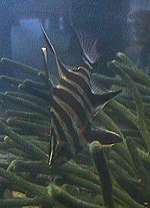| |
|
|
Australia's marine environment stretches from the warm tropical waters of northern Australia more than 3,700 kilometres to the cool waters influenced by the Southern Ocean in the south. From east to west it is over 4,000 kilometres from Shark Bay to Cape Byron.
Within these boundaries are many different types of habitats including coral reefs, seagrass meadows, soft sediment bottoms, mangrove forests, salt marshes, temperate rocky reefs and kelp forests, benthic communities at varying depths and open oceanic waters. Each of these communities support a diverse range of living things - biodiversity.
This means that when it comes to considering the number of species that inhabit our marine and coastal waters, Australia is a mega-diverse nation. The sheer number of species found in Australian waters is staggering. Many species of smaller organisms still have not been fully investigated and new species are still to be discovered and described. Australia is one of about 12 countries that between them harbour around 70 per cent of life on the planet. |
 |
Some idea of the rich tapestry of species that make up our marine and coastal communities can be seen from the following bio-facts:
- Australian cool water environments support over 1,150 species of macro-algae or seaweeds, more than 50% more than any comparable area on the planet.
- Most of the marine life found in southern Australian waters is endemic, in other words is found nowhere else in the world.
- More than half the worlds' seagrass species are found in Australia with 11 out of 12 of the different seagrass genera represented. Western Australia's seagrass meadows are the most diverse in the world.
- 40 out of 55 of the world's mangrove species are found in Australia.
- The total number of invertebrate species in Australian seas is unknown but believed to be in the tens of thousands with many species still unnamed.
- Australia's waters support the worlds largest number of bony fish species, with over 4, 000 species compared with 2,268 fish species in North America or only 1,248 species in the Mediterranean.
- More than 296 species of cartilaginous fish are found in Australian waters including 166 sharks, 117 rays, and 13 chimaeras or ghost sharks. More than half of these are only found in Australia.
- 30 of the world's 50 species of sea snakes are found in Australia along with 6 of the 7 world's species of turtles.
- Australia and its territories support 110 species of seabirds and a further 34 species migrate to Australia from the northern hemisphere.
- Australian waters support the world's last significant populations of dugongs, a species listed as vulnerable to extinction.
- More than 60% of the world's cetacean species spend some time in Australian waters, including many species that breed in Australia. Of these there are 8 species of baleen whales and 35 species of toothed whales, dolphins and porpoises.
- Our seas contain many thousands of different types of microscopic marine algae, fungi, and bacteria.
- The Great Barrier Reef is home to 2000 species of fish and ¾ of the world's corals.
Next: Value of biodiversity
|
|
|
|